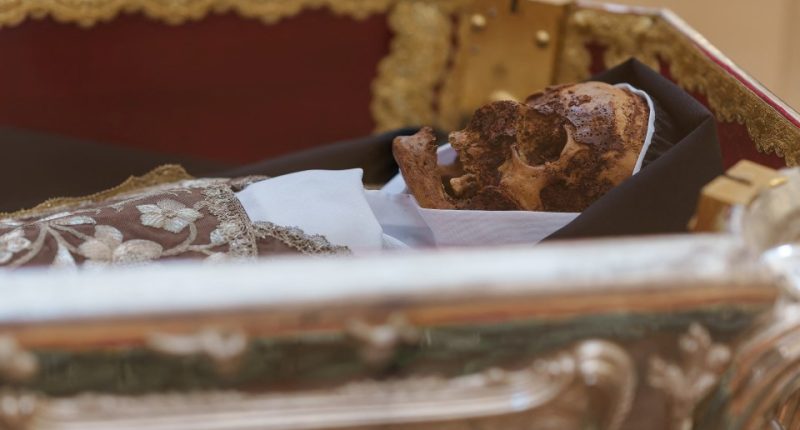Share this @internewscast.com
THE staggeringly well preserved corpse of a 16th century Catholic saint has been unveiled to the public.
Many faithful Catholics were left overwhelmed when they saw the 440-year-old body of Saint Teresa of Jesus inside a glass coffin in Spain.
For the first time since 1914, the body of a Discalced Carmelite nun was presented to the public at the Basilica Annunciation of Our Lady of Mount Carmel, located in Salamanca, Spain, on Sunday.
While visibly skeletal at a glance, parts of the corpse are said to still be remarkably well preserved.
Several visitors at the Basilica were visibly emotional at the sight of the centuries-old body.
One worshipper present was pictured with her hand over her mouth upon catching a glimpse of the saint.
Another seemed to be on the verge of tears, while many others were seen praying before St. Teresa’s corpse.
Discalced Carmelite nuns, monks and priests had opened her coffin so that relics of her heart, hand and arm could be studied.
They compared the state of the body to a photo of the same remains from 1914.
“The uncovered parts, which are the face and foot, are the same as those they were in 1914,” Father Marco Chiesa said.
“There is no colour, there is no skin colour, because the skin is mummified, but it is seen, especially in the middle of the face.”
It came as part of a ceremony of public veneration – which has only taken place three times since the saint’s death in 1582, according to Exaudi.org.
Prior to this, similar ceremonies took place only in 1760 and 1914, offering a rare and special opportunity for believers to honor her in this manner.
Researchers have marvelled at the body’s incredible state of preservation.
A 53-page initial report, published in March, highlighted the remarkable preservation of the body, according to the Spanish news platform Salamanca RTV Al Dia.
Professor Luigi Capasso, leader of a team of Italian anthropologists, said: “The right foot, left hand, heart, and left arm are perfectly preserved, with intact skin, subcutaneous tissue, and muscles in place, and no signs of degradation.”
The preservation of her body is likely down to dry environmental factors in the tomb – and no artificial mummification was involved – according to the team.
“It’s a truly unique natural phenomenon,” Professor Capasso added.
Saint Teresa of Jesus died aged 67 in 1582 and was canonised – meaning made a saint – by Pope Gregory XV in 1622.
Her’s is not the only body of a revered Catholic figure to have drawn flocks of the faithful to pay respects.
Devotees came this spring to the Sanctuary of the Spoliation in the Church of Santa Maria Maggiore in Assisi to catch a glimpse of the late Carlo Acutis.
Carlo was a Catholic teenager known as “God’s influencer”, who has since been beatified – meaning he is on the path to sainthood.
Who was Saint Teresa of Jesus?

Born in 1515, St. Teresa of Jesus was a leading Spanish nun and mystic in the Catholic Church.
Also known as St. Teresa of Ávila, she was known as a leading reformer of the Carmelite Orders of monks and nuns.
She was the first woman to be granted the honour of Doctor of the Church – marking her out as a significant contributor to Catholic teachings.
Despite health problems throughout her life, she became a key spiritual leader during the Counter Reformation – one of the most turbulent episodes of the Church’s history.
She died in October 1582 and was declared a saint 40 years later in 1622.





















